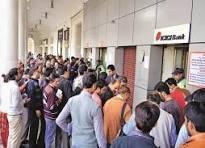
Why Financial Inclusion?
Though the banking industry has shown significant improvements in all the areas relating to financial viability, profitability and competitiveness, there are concerns that banks have not been able to include vast segment of the population, especially the underprivileged sections of the society, into the fold of basic banking services.
Unrestricted access to public goods and services is the sine qua non of an open and efficient society.
As banking services are in the nature of public good, it is considered that banking and payment services be made available to the entire population without discrimination.
What is Financial Inclusion?
Financial Inclusion is delivery of banking services at an affordable cost to the vast sections of disadvantaged and low-income groups.
Financial Inclusion has the potential to lift the financial condition and standards of life of the poor and the disadvantaged.
What are the consequences of Financial Exclusion?
Consequences of financial exclusion will vary depending on the nature and extent of services denied.
It may lead to frequent travel to access credit, higher incidence of crime, general decline in investment, difficulties in gaining access to credit or getting credit from informal sources at exorbitant rates, and increased unemployment etc.
The financially excluded people may suffer due to lack of access to market their produce to middles class and higher income consumers, higher cash handling costs, delays in remittances of money etc.
According to certain research findings, financial exclusion can lead to social exclusion.
Financial Inclusion – Is it only for poor countries?
NO. Financial Inclusion has been attracting increased attention even in developed countries. It has been observed that more developed the country is, greater the trust on empowerment of common man and low income groups.
Financial Inclusion Task Force in UK has identified three priority areas for the purpose of financial inclusion, viz., access to banking, access to affordable credit and access to free face-to-face money advice.
UK has established a Financial Inclusion Fund to promote financial inclusion and assigned responsibility to banks in removing financial exclusion, Basic no frills bank accounts have been introduced.
In the United States, a civil rights law, namely Community Reinvestment Act (CRA) prohibits discrimination by banks against low and moderate income neighborhoods.
The CRA imposes affirmative and continuing obligations on banks to serve the needs for credit and banking services of all the communities in which they are registered.
What is the Indian scenario?
Indian Banking sector has been innovating with various alternatives to provide the financial services, though primarily credit, in rural areas.
Number of branches of commercial banks and the RRBs increased from 8321 in the year 1969 to 68,282 branches as at the end of March 2005.
The average population per branch office has decreased from 64,000 to 16,000 during the same period.
It should be noted that at this rate 20 years were required to cover entire population under Financial Inclusion. Then came the greatest “change” in the approach in 2014.
Since 2014 India achieved a revolution in Financial Inclusion. The Govt. of India advised the Banks to ensure that every family to have at least one Bank Account. This gigantic goal was achieved by opening 17.5 crore Bank accounts under “Jan Dhan Scheme” within a period of 6 months. This achievement has no parallel in the history of banking any where in the world.
These Jan Dhan Accounts are effectively used to Directly Transfer Benefits (DBT) to the beneficiaries of various Government Schemes. Further, through these accounts crores of people are covered under Accident Insurance and Life Insurance (for the first time in their life) creating another world record.
What are the measures taken by the RBI?
With a view to enhancing the financial inclusion, as a proactive measure, the RBI in its Annual Policy Statement for the year 2005-06, urged banks to review their existing practices to align them with the objectives of financial inclusion.
In the Mid Term Review of the Policy (2005-06), RBI exhorted the banks, to make available a basic banking ‘no frills’ account either with nil or very minimum balances as well as charges that would make such accounts accessible to vast sections of the population.
Later, with a view to extend hassle-free credit to customers, it was suggested that banks introduce a scheme to extend loans for general purposes under General Credit Card, to be implemented in rural and semi-urban areas.
How is it beneficial to branches?
Providing mass banking with no-frills SB, General Credit Card etc. can become a win-win situation for the Branch and also the People. Basically these banking services need to be “marketed” to such population segments.
Branches can extend banking facilities to the low income people, on relaxed terms.
Branches can enlarge the clientele base and build up low cost deposits.
Branches can achieve targets under agriculture / priority sectors, since 50% of the credit outstanding under GCC can be classified as indirect finance to agriculture.
Branches can increase the business volume, as the banking relationship can be used for cross selling other asset and also liability products.
Photo: People waiting for serveces at a Bank Branch
